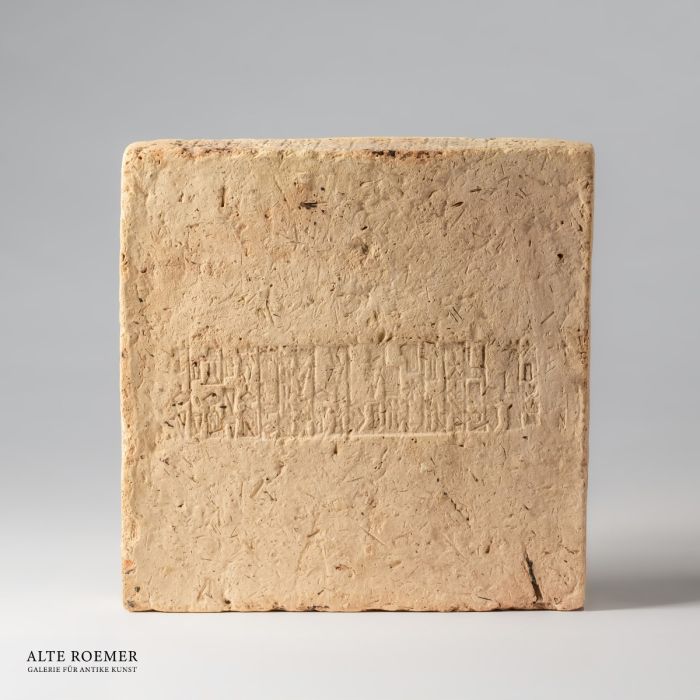Sumerian brick with royal inscription
€6,000
available
Object number
AR3533A
| Object: |
Sumerian brick with royal inscription
|
| Material: |
Fired clay.
|
| Period: |
2046 BC to 2038 BC Reign of Amar-Sin, third king of the Third Dynasty of Ur. Ur III period, at the end of the Early Bronze Age of Mesopotamia. |
| Description: |
Brick from the Temple of Eridu, donated by King Amar-Sin (also referred to as Amar-Suen). The clay brick is square and bears 13 lines of Sumerian cuneiform stamped on one face side (rotated by 90° on the photo) and on one edge. It is a well-known royal inscription with the following reading.
A somewhat loose but well readable translation is as follows:
The Abzu is an underground freshwater reservoir, the source of all life and fertility in Sumerian mythology, and the mighty god Enki rules over it. It must refer to the temple of Enki in this context. |
| Background: |
This brick comes from the cradle of civilization — that's how one could describe the Temple of Eridu, at least, with a bit of imagination. Eridu is one of humanity's first cities and, according to Sumerian myth, the place where history began. King Amar-Sin, a ruler of the Third Dynasty of Ur, distinguished himself through monumental building projects and religious devotion. The brick was used in the maintenance of the temple, which had been expanded into a ziggurat, an act of royal piety meant to secure the favor of the god Enki. The inscription served as a lasting testament to royal power. This artifact is therefore not just building material — it is a tangible piece of world history.
|
| Dimensions: |
Approximately 26cm x 26cm x 7cm.
|
| Condition: |
Perfect condition. Complete and intact. The minor chips and edge damage are mostly ancient and not distracting. The cuneiform writing is not perfectly sharp due to some wear of the ancient stamp or subsequent erosion, but is still easily visible enough for reading. Loosely adhered surface. Ancient plaster residue on the reverse.
|
| Provenance: |
Acquired by us in 2024 from the German Maempel family collection. It was added to the collection in March 1983 in Iraq and exported to Germany in 1984. The find site is the Sumerian city of Eridu, in present-day southern Iraq. The brick was described and translated by the National Museum of Iraq in 1983. The museum requested the use of the brick for the University of Toronto's research project Royal Inscriptions of Mesopotamia. It thus contributed to the Ur III Period volume of the series, that contains a chapter devoted to the inscriptions of King Amar-Sin, including the well-known inscription presented here. Fortunately, this brick remained in private hands and thus escaped the looting of the Iraq Museum in 2003. |
| Publication: |
Bricks with identical inscription in Douglas R. Frayne, The Royal Inscriptions of Mesopotamia, Early Periods Volume 3/2, Ur III Period (2112-2004 BC) (University of Toronto Press, 1997), pp. 260ff, no. 15. In the table there, line 32 presumably refers to the three bricks from the Maempel collection researched by the National Museum of Iraq, including the brick offered here.
|
| References: |
Cf. British Museum, museum no. 90279, representative of a total of 31 bricks with this inscription in the British Museum, thus the largest group of just over 50 documented bricks of this type in total worldwide.
|
| Literature: |
Douglas R. Frayne, The Royal Inscriptions of Mesopotamia, Early Periods Volume 3/2, Ur III Period (2112-2004 BC) (University of Toronto Press, 1997), pp. 235 to 244 for a comprehensive report on the research on king Amar-Sin. Christopher B. F. Walker, Cuneiform Brick Inscriptions in the British Museum (BMP, London, 1981). |
| Authenticity: |
We unconditionally guarantee the authenticity of every artefact, all items are subject to our lifetime return policy on authenticity.
|


